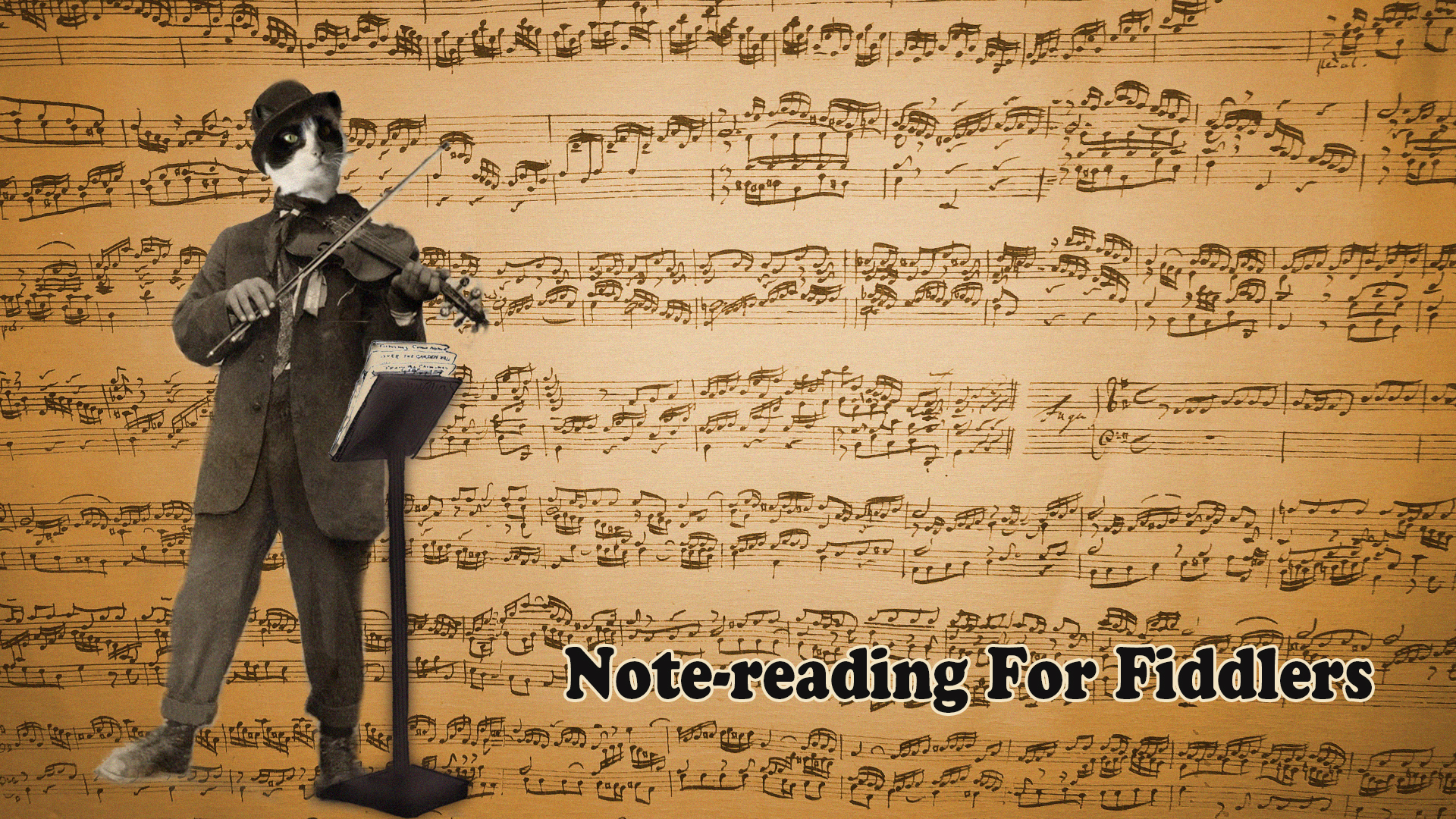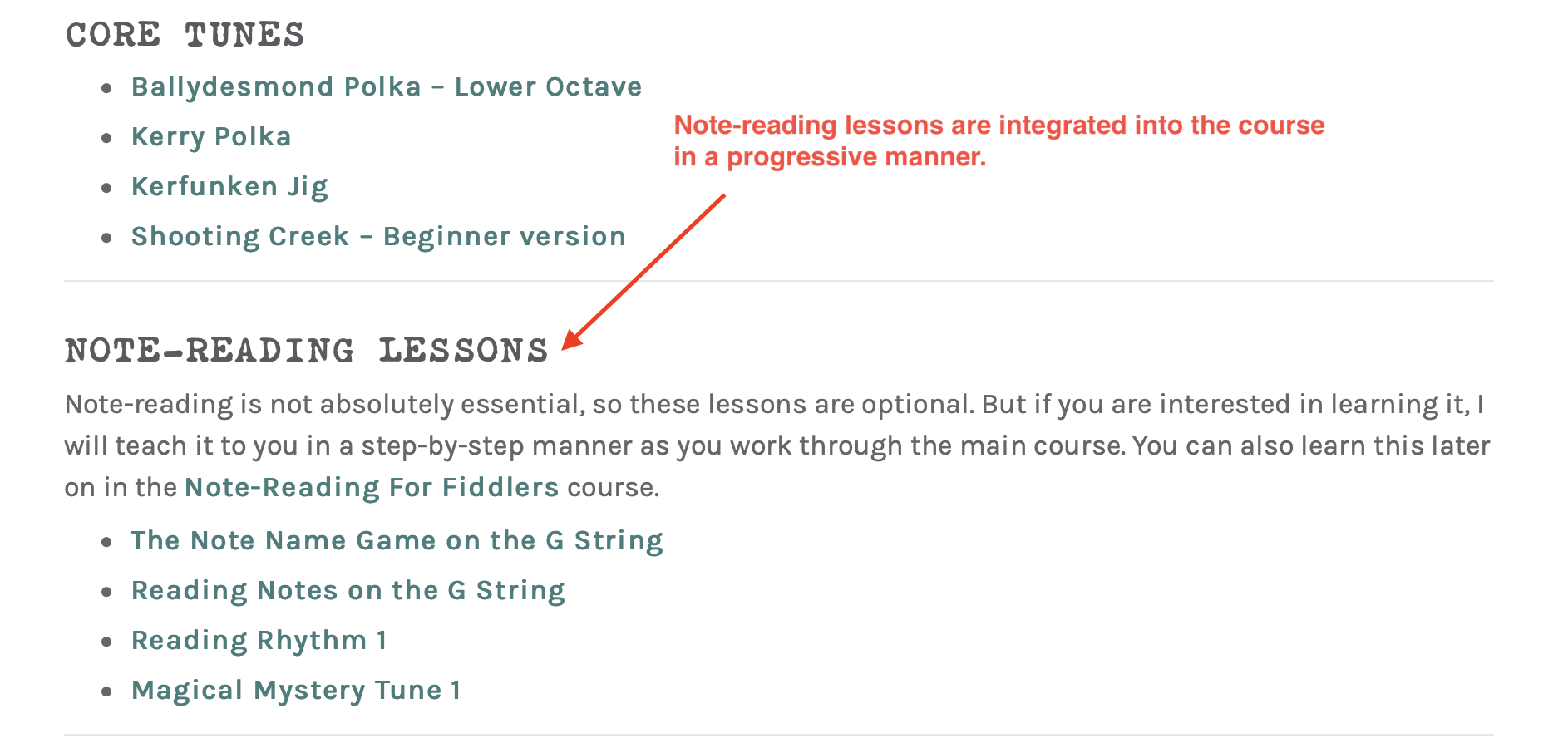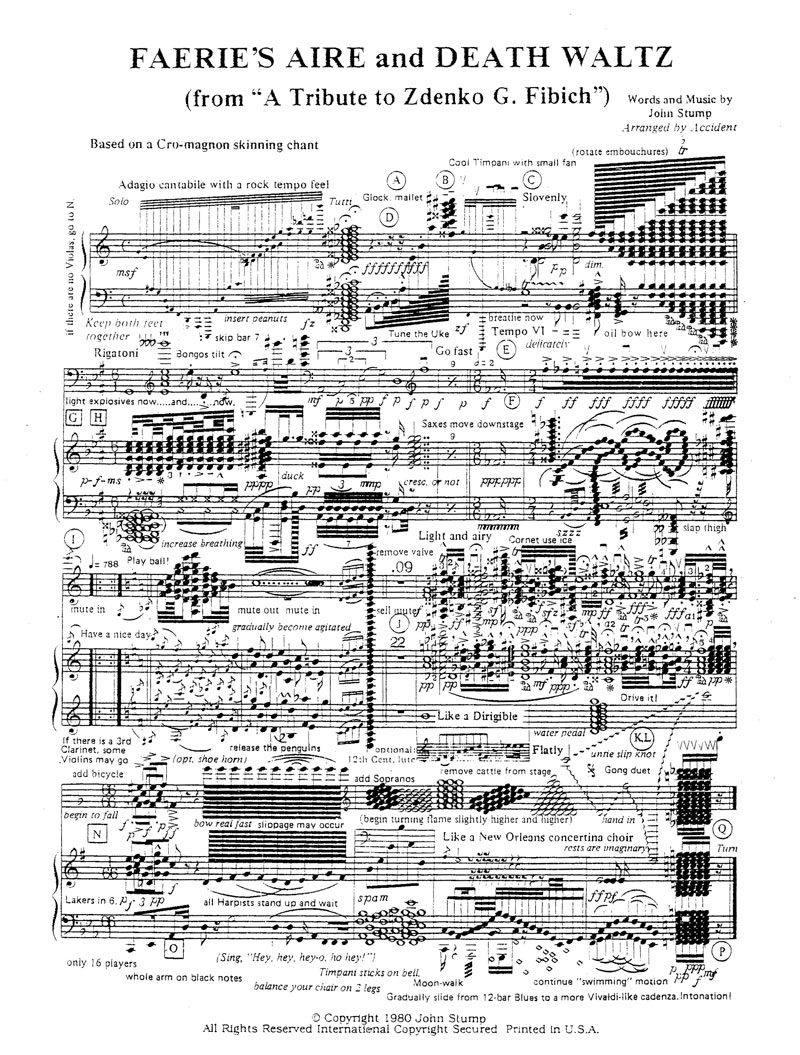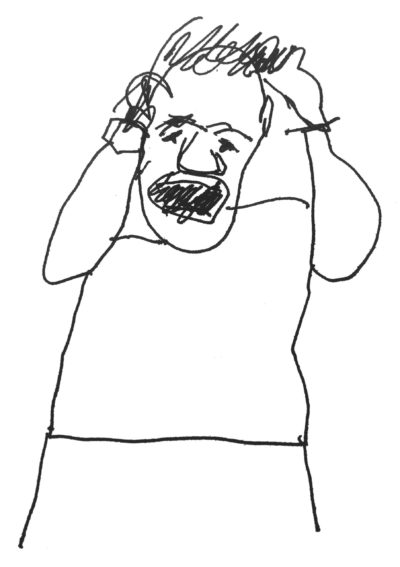Note-Reading For Fiddlers

The ability to read sheet music can help you to learn and play the tunes that you love. Though I teach by ear in the FiddleHed course, I suggest that all students eventually learn to read violin notes. Note-reading will open up new worlds of discovery and learning for you!
Here are the key ideas of the course:
- Learn to play
- Learn to read what you’ve already learned to play
- Learn rules and theory once you’re able to read
In this course, you’ll practice note-reading with progressive exercises. In addition to these specific note-reading exercises, you can use any of the LearningChunks™ to practice note-reading.
Two ways to use these lessons
You can learn to read as you work through the main course:

Or, you can focus on note-reading using the outlines below:
Course outline
If you are new to note-reading and also a beginner at the fiddle, I suggest you take the lessons in this order. That’s because this sequence will most closely follow the progression of lessons in the course.
- Note-reading For Fiddlers Overview
- The Note Name Game on the D string
- Intuitive Note-Reading
- Reading Notes on the D String
- How do I know that a note on the staff is a sharp?
- Creative Note-Reading Practice
- Reading Notes on the A String
- Reading Rhythm 1
- Reading Notes on the G String
- Reading Rhythm 2
- Reading Challenge 1
- Finding Patterns in Sheet Music
- Reading Notes on the E String
- Reading Rhythm 3
- Reading Challenge 2
- Reading Rhythm 4
- 7 Tips For Reading Sheet Music
- Reading Challenge 3
- Note-Reading Workshop: Kerfunken Jig
- Reading Challenge 4
- Reading Challenge 5
- Reading Low Second-Finger Notes
- How To Simplify Fiddle Sheet Music
- Reading Challenge 6
- Learning Fiddle Tunes From Sheet Music
- Musical Terminology – Crash Course
- Note-Reading For Fiddlers webinar – August 12, 2020
Lessons listed by type
This might be better for intermediate to advanced fiddlers. You can practice what you need depending on what you really need help with.
Note Name Game lessons
For the record, the first lesson explains the game. Then we just play the same game with notes on other strings. If you make it a habit to learn the note names as you go, then it may not be necessary to take the other note name game lessons.
- The Note Name Game: D string
- The Note Name Game: A string
- The Note Name Game: G string
- The Note Name Game: E string
- The Note Name Game: Low Second Finger Notes
Intuitive Note-Reading Lessons
- Intuitive Note-Reading
- Creative Note-Reading Practice
- Finding Patterns in Sheet Music
- Learning Fiddle Tunes From Sheet Music
- 7 Tips For Reading Sheet Music
- How To Simplify Fiddle Sheet Music
Note-reading practice
- Reading Notes on the D String
- Reading Notes on the A String
- Reading Notes on the G String
- Reading Notes on the E String
- Reading Rhythm 1
- Reading Rhythm 2
- Reading Rhythm 3
- Reading Rhythm 4
- Reading Low Second-Finger Notes
- Note-Reading Workshop: Kerfunken Jig
Note-reading Challenges
- She’ll Be Comin’ Round the Mountain
- This Old Man
- This Land Is Your Land
- Take Me Out To The Ballgame
- Perpetual Motion
- Minuet In G – Bach
Theory/terminology
Further sight-reading practice
If you want further practice, I suggest you look through the early modules or the course. Use simple, familiar tunes to practice sight-reading, audiation and writing sheet music. Some suggestions:
- Twinkle, Twinkle Little Star
- Fais Do Do – Beginner
- Freres Jacques
- Ode to Joy
- London Bridges
- Wildwood Flower
- Wabash Cannonball
- Will the Circle Be Unbroken
- I Saw the Light
- Pretty Polly
Here are some more intermediate level tunes that are good sight-reading practice because they have a lot of repetition:
Do you want to read sheet music?
“Yes, but last time I tried, it didn’t make sense. I was totally frustrated and went back to just playing by ear.”
A lot of violinists and fiddlers are intimidated by note-reading. It doesn’t seem worth the effort. They look at sheet music and see something like this:

And then feel like this:

A natural way to learn note-reading
I get it. A lot of fiddle books and violin methods briefly tell you the rules for sheet music in the first two pages of a book. Then you’re thrown into the deep end of the pool. You’re expected to magically be able to read the notes after this quick brief instruction.
I created the Note-Reading For Fiddlers course to help you learn to read sheet music in the simplest way possible. You don’t need to learn a bunch of terminology. You’ll rely on the brain’s natural ability to read patterns. I talk more about this below and in many of the lessons in the course.
“Do I really even need to be able to read sheet music?”
Short answer: It’s not absolutely necessary. Some of the most gifted and influential musicians never learned to read….Tommy Jarrell, Robert Johnson and Mozart (on second thought, I think this guy could read a bit).
Learning to read can accelerate your learning. This is especially true if you can play the same tune for memory. The note-reading skill allows you to form better mental models of the tune. This will help you to remember it, see repeating patterns and make connections.
Note-Reading can improve your practice. As you’ll learn in the course, if you cultivate the note-reading skill, it will allow you to more easily flag difficult parts. It will also allow you to add your own slur markings.
Learning to read music can open new doors. It will allow you to learn from books or sheet music downloaded from the internet. The note-reading skill can also open up new opportunities that you may enjoy: New tunes, new styles, and new experiences, like playing in bands or a community orchestra.
Note-reading For Fiddlers Overview >>
Leave a Reply
You must be logged in to post a comment.

Hi I’m wondering how I can get finger notes or placements for fiddle tunes I listen to on YouTube
Great point, Shanni. There’s a post on learning songs from youtube here: https://fiddlehed.com/courses/beginner-fiddle-lessons/1-8-the-high-and-low-second-finger/how-to-learn-tunes-from-youtube/
I also tend to use blank sheet music pages and once I get a small section of a tune, I’ll write it down. This could be helpful to do even simply in tab form.
If you want help in achieving this with a specific song, we can discuss further support options via support@fiddlehed.com
Be great to hear how you do with this. Have fun 🎶
I noticed this when seeing tab above the sheet music, maybe it will help those trying to go from tab to notes by giving them a little hint.
If you look at the lines the notes are written on and then think of the finger numbers in tab, when a note sits between two lines then that note is played with 0-2-4 finger. I think of it as even, not mathmatical but who cares. If the note sits with a line running through it, one line right smack across it, it is played with finger 1 or 3. It’s odd, just like me. Amazing.
Just think, all those notes, so many it’s daunting. But if a line goes through them it’s only gonna be f1 or f3. For me, it tamed the visual freeze from seeing sooooo much I don’t know. If, in just trying to familiarize yourself, you look at a piece more advanced, circle the “odd” notes. In all that confusing squiggle, hahahahaha! Only finger 1 or 3. Out of 10 fingers, only two possibles.
I’m sure there are exceptions somewhere but I’m not advanced enough, YET, to find them. Once I saw this little oddity, it pulled out of overload and reinforced this- right now, one finger at a time.
I know it’s simplistic but it helped me click.
Looking forward to diving into this session! I’m a pretty strong sight-reader, and it’s been both a blessing and a curse. It affords me the opportunity to learn new tunes, but on the flip side, I’ve become to use it as a crutch. If I can’t figure out a tune by ear, I fall back to the sheet music to help me out. It may be my Achilles heel to memorizing tunes. Thanks!
This is just what I’m looking for to help improve my reading skills. The combination of 8th and 16th really helps!
Hi Jason….I was really hoping I could learn to fiddle with tabs but I’m going to give learning note reading a chance. It does seem a bit over whelming though.
Interesting reading the comments above. I started learning just on 3 years ago, learning by ear, but am now working on learning how to read music because the tunes are starting to get jumbled in my head.
I’m ok once I have the first few notes and the rhythm of the ones I’ve learned, but sometimes 2 will get mixed together in my head, especially if they are a similar beat, start on the same note, and/or I learned them around the same time. I’m hoping that learning to read will enable me to refresh my memory when I go to play something I haven’t played for a while so I can get started without muddling things up.
Something others might find useful; I’ve found Musescore quite handy as I can either type the notes in, or import the sheet music, then play along while watching where I’m up to. They also have quite a bit of sheet music already there. You can slow the speed while learning and set it to loop sections like Jason does when teaching. It’s free software.
Good idea @monicab. I use Sibelius for notation, but I want to look at Musescore. It might be a good way for FiddleHed students to practice writing notation.
I’m starting to get to the stage (7 months in) that I find I would like to start reading the notes on the page as well as the tab version, but I don’t want to halt my progress with playing. Should I wait a little longer before I start trying to get to grips with the notes, or should I dive in and risk stepping back a stage or two?
So glad to get some guidance about “tethering,” as I have experienced this issue—playing a tune from sheet music just fine, but being unable to look away from the music and play it from memory. Thanks, Jason!
Agreed! I learned to sight read as a kid – but haven’t played in 30 + years.
Now that I’m diving in – I’m way to dependent on sheet music to help me remember tunes. Great feedback!